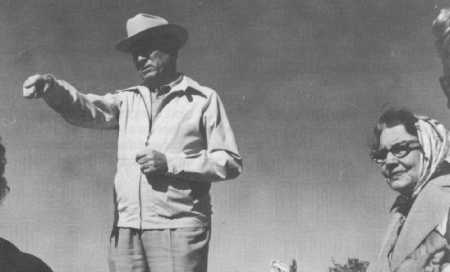
A study of the prehistory of Ector County would not be complete without mention of the meteor crater. Julius Drew Henderson, son of pioneer rancher J. J. Henderson wrote in 1959 that, "although some people in the last 30 years have claimed the honor of discovery of the meteor site here, I believe I was likely the first person to see that place and realize something had happened there. We lived 3 miles west of Odessa in the winter of 1892.
There was a big snow and our calf got out with the milk cow with a long rope on her. The cow was gone for a few days and came back without the calf. I got on a horse and followed her back to the calf about five miles from our house. The calf was in that place (the meteor crater) with the rope tangled about a bush. After the snow melted, I went back to look at the place. I told my father what I had found and he laughed at me. He bought a ranch near that place in 1896 and his headquarters was only 2 miles east of there.
We ranched there 35 years, yet people claim to have discovered that place (the crater) as late as 1927. I had seen a peice of what I thought was red rock there but had never picked it up. My son, Richard picked it up one day and found it to be very heavy. I brought it to town to show and gave it to Mayor McKinnery. He sent it to Pittsburgh and had it cut open and examined. They said it was nickel steel and very hard. All these lakes or depressions are underlayered with a reddish looking lava rock that is extremely hard and were undoubtedly caused by a shower of heavenly bodies."
What Mr. Henderson describes are the remnants of the crash of a meteor about 25,000 years ago. The original hole of the main crater was 550 wide and an estimated 100 fee deep. The inpact was so great that the layers of limestone were torn from their horizontal beds and left completely upright.
In 1939, Dr. Sellards of U.T. Austin initiated a scientific study of the meteor crater. The co-operative venture was supported by the Federal WPA, the Bureau of Economic Geology at U.T. Austin and Ector County and directly supervised by Glen Evans. For over two years, 35 men diligently worked to map the area, get samples, do core drillings and remove milleniums of dirt and top soil. They even managed to build a shaft 165 feet deep before WW II interupted their work.
In 1958 Evans returned to supervise another scientivic study of the crater. His team of scientists discovered three major craters surrounded by hundreds of indentations caused by smaller fragments falling to earth in what they proved to be a meteor shower. Evans' discoveries during his return to Odessa's Meteor Crater prompted a reexamination and new understanding of meteor craters around the world.
Ector County still maintains the Meteor Crater site for visitors who want to see the third largest meteor crater in the world.
Go to Meteor Crater site.
Courtesy: The Flavor Of Odessa, 1891-1991; editor:Ann Sherburn.
The Heritage of Odessa Foundation.